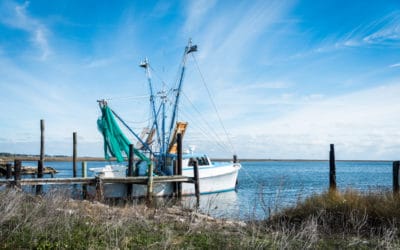Recently, I had the opportunity to speak at the 8th annual North Carolina Catch Summit and was asked to talk about the state of North Carolina’s commercial fisheries. After a lot of thought, I chose to talk about what I refer to as the “unintended consequences” of fisheries management. When I say unintended consequences, I’m not referring to the social and economic hardships we’re all familiar with. While those impacts can be devastating, they are expected when you reduce harvest, and are meant to be temporary. By now, every fisherman reading this is shaking their head in disgust because in North Carolina there is no such thing as temporary management measures, with the exception of those that have been made more restrictive. Even worse, we seldom, if ever achieve any reduction in total removals through the harvest reductions we adopt, which is why they are never lifted.
Now hold on, before everybody starts cussing me, I’m not saying that certain individuals or sectors have not seen reductions in harvest. They have, but total numbers of fish killed is seldom reduced. But why? This is where the unintended consequences of fisheries management come into play. The truth is – management measures adopted to reduce fishing mortality on species like Red Drum, Speckled Trout, and Southern Flounder have done little more than reallocate the resource from one user group to another. For example, when North Carolina started managing Red Drum, recreational removals accounted for around 70% of Red Drum killed annually. Today, recreational removals make up 90% of the total, representing a 20% reallocation. The fact is the management measures have been successful at reducing commercial impacts, but have failed to have any significant impact recreationally. Since the Red Drum Fishery Management Plan was adopted, the total average number of fish removed from the stock has more than doubled, from 1,895,344 fish (1989-1998) to 4,349,365 fish (2008-2017) without decreasing a single restriction. The recreational sector is solely responsible for the increase in total mortality, meaning they alone have benefited from the commercial reductions. The FMP has failed to “reduce directed and bycatch mortality” – a key objective of the plan, but have succeeded at freezing the commercial footprint, effectively reallocating the resource.
Another unintended consequence of management is the waste created by increasing dead discards. Again, this is the most evident in the recreational sector. From 2008 to 2017 dead discards in the recreational Red Drum fishery are responsible for 1,568,177 dead fish – equal to the number of Red Drum removed by commercial fishing over the 29-year period from 1989 to 2017. A similar scenario has occurred in North Carolina’s attempt to manage the Speckled Trout fishery. Despite the adoption of management measures meant to reduce removals by 40%, there has been no apparent reduction in the total removals of Speckled Trout. In fact, preliminary data suggests that the 2019 total removals are the highest on record, with the recreational sector being responsible for well over 90%.
Much like Red Drum, our inability to manage recreational fisheries has prevented commercial fishermen from benefiting from the abundant Speckled Trout that nature (not management) has provided. All while allowing North Carolina anglers’ catches to steadily increase, with the only limiting factor being the number of fish available annually. Reallocation of the resource is much more evident in the Southern Flounder fishery because unlike Trout and Drum, commercial removals have traditionally been the dominant source of mortality. Prior to the year 2000, the commercial sector was responsible for the total flounder removals in North Carolina, but as regulations piled up, commercial harvest dropped to record lows and now only accounts for 60% of the total number of North Carolina’s flounder removals.
One significant difference in the flounder fishery is that unlike Trout and Drum, the total coastwide (NC to FL) removals have decreased over time. Unfortunately, the commercial sector is responsible for the entire reduction, as the total number of flounder removed recreationally has changed very little over the years. But… This time North Carolina anglers are not the only ones to reap the benefits. Since we share a Southern Flounder stock with South Carolina, Georgia, and Florida, their anglers have also benefited from North Carolina’s commercial reductions.
While many point to the recent reduction in total removals as a sure sign the Southern Flounder stock is declining, I’m not so convinced. From what I have seen, the total numbers of Southern Flounder being caught annually has significantly increased in recent years. North Carolina anglers alone released nearly 2 million flounder in 2017, and only harvested 221,321 fish. Now this may sound like a great conservation strategy, but with a 15-inch size limit, the majority of the fish harvested are sexually mature females, and the overwhelming majority of released flounder are juveniles. Common sense tells me that if we want to maximize production, the number of fish harvested annually should be influenced by the number of juveniles produced in a given year rather than the number of females reaching maturity! In my opinion, by shifting harvest to mature females, we have prevented the expansion of the spawning stock, resulting in one of our state’s most valuable fisheries being decimated by decades of regulations!
Don’t get me wrong, I’m not suggesting that any management measure will create fish, because even the best management options do nothing more than protect existing fish until they create more fish. What I’m saying is that there is a percentage of every fish stock that is more valuable reproductively, and they should be the focus of management, not harvest. Even if we get this right, for management to work, it first and foremost has to work for everybody. That is where fisheries management in North Carolina has truly failed.
- Glenn Skinner
Executive Director, North Carolina Fisheries Association

Related Articles
A Word From The Chairman
Related Articles Stay Up to Date With The Latest News & Updates Join Our Newsletter
A Word From Jerry Schill
Related ArticlesStay Up to Date With The Latest News & UpdatesJoin Our Newsletter
An Update From Glenn
Related Articles Stay Up to Date With The Latest News & Updates Join Our Newsletter



